Metallica theme by Shpaz
Download: Metallica.p3t
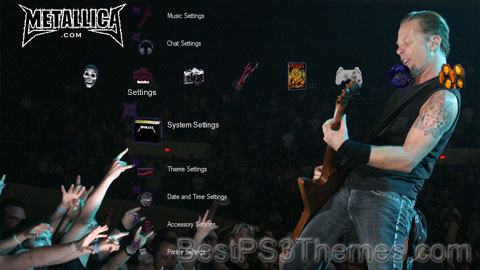
(8 backgrounds)
Metallica | |
|---|---|
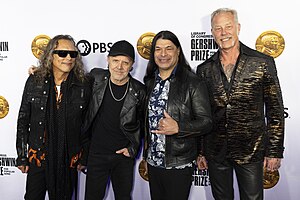 Metallica at the 2024 Gershwin Prize ceremony. From left to right: Kirk Hammett, Lars Ulrich, Robert Trujillo and James Hetfield. | |
| Background information | |
| Origin | Los Angeles, California, U.S. |
| Genres | |
| Discography | Metallica discography |
| Years active | 1981–present |
| Labels | |
| Spinoffs | |
| Spinoff of | Leather Charm |
| Members | |
| Past members | |
| Website | metallica |
Metallica is an American heavy metal band. The band was formed in 1981 in Los Angeles by vocalist and guitarist James Hetfield and drummer Lars Ulrich, and has been based in San Francisco for most of its career.[1][2] The band's fast tempos, instrumentals and aggressive musicianship made them one of the founding "big four" bands of thrash metal, alongside Megadeth, Anthrax and Slayer. Metallica's current lineup comprises founding members and primary songwriters Hetfield and Ulrich, longtime lead guitarist Kirk Hammett and bassist Robert Trujillo. Guitarist Dave Mustaine, who formed Megadeth after being fired from Metallica, and bassists Ron McGovney, Cliff Burton and Jason Newsted are former members of the band.
Metallica first found commercial success with the release of its third album, Master of Puppets (1986), which is cited as one of the heaviest metal albums and the band's best work. The band's next album, ...And Justice for All (1988), gave Metallica its first Grammy Award nomination. Its fifth album, Metallica (1991), was a turning point for the band that saw them transition from their thrash roots; it appealed to a more mainstream audience, achieving substantial commercial success and selling more than 16 million copies in the United States to date, making it the best-selling album of the SoundScan era. After experimenting with different genres and directions in subsequent releases, Metallica returned to its thrash metal roots with its ninth album, Death Magnetic (2008), which drew similar praise to that of the band's earlier albums. The band's eleventh and most recent album, 72 Seasons, was released in 2023.
In 2000, Metallica led the case against the peer-to-peer file sharing service Napster, in which the band and several other artists filed lawsuits against the service for sharing their copyright-protected material without consent, eventually reaching a settlement. Metallica was the subject of the acclaimed 2004 documentary film Metallica: Some Kind of Monster, which documented the troubled production of the band's eighth album, St. Anger (2003), and the internal struggles within the band at the time. In 2009, Metallica was inducted into the Rock and Roll Hall of Fame. The band co-wrote the screenplay for and starred alongside Dane DeHaan in the 2013 concert film Metallica: Through the Never, in which the band performed live against a fictional thriller storyline.
Metallica has released eleven studio albums, four live albums (including two performances with the San Francisco Symphony), twelve video albums, one cover album, two extended plays, 37 singles and 39 music videos. The band has won ten Grammy Awards from 26 nominations and had six consecutive studio albums – from Metallica through Hardwired... to Self-Destruct (2016) – debut at number one on the Billboard 200. Metallica ranks as one of the most commercially successful bands of all time, having sold more than 125 million albums worldwide as of 2018[update].[3] Metallica has been listed as one of the greatest artists of all time by magazines such as Rolling Stone, which ranked the band in 61st place on its list of 100 greatest artists of all time.[4] As of 2017[update], Metallica is the third-best-selling music artist since Nielsen SoundScan began tracking sales in 1991,[5] selling 58 million albums in the United States.[6]
History[edit]
1981–1984: Formation, early years, and Kill 'Em All[edit]

Metallica was formed in Los Angeles in late 1981 when Danish drummer Lars Ulrich placed an advertisement in a Los Angeles newspaper, The Recycler, which read, "Drummer looking for other metal musicians to jam with Tygers of Pan Tang, Diamond Head and Iron Maiden."[9] Guitarists James Hetfield and Hugh Tanner of Leather Charm answered the advertisement. Although he had not formed a band, Ulrich asked Metal Blade Records founder Brian Slagel if he could record a song for the label's upcoming compilation album, Metal Massacre. Slagel accepted, and Ulrich recruited Hetfield to sing and play rhythm guitar.[9] The band was officially formed on October 28, 1981, five months after Ulrich and Hetfield first met.[10][11]
The band name came from Ulrich's friend Ron Quintana, who was brainstorming names for a fanzine and was considering MetalMania or Metallica. After hearing the two names, Ulrich wanted the latter for his band, so he suggested Quintana use MetalMania instead.[12] Dave Mustaine replied to an advertisement for a lead guitarist; Ulrich and Hetfield recruited him after seeing his expensive guitar equipment. In early 1982, Metallica recorded its first original song, "Hit the Lights", for the Metal Massacre I compilation. Hetfield sang and played both bass and rhythm guitar, while Lars Ulrich played drums and Lloyd Grant was credited with a guitar solo.[9] Metal Massacre I was released on June 14, 1982; early pressings listed the band incorrectly as "Mettallica", angering the band.[13] The song generated word of mouth, and the band played its first live performance on March 14, 1982, at Radio City in Anaheim, California, with newly recruited bassist Ron McGovney.[14] Their first live success came early; they were chosen to open for British heavy metal band Saxon at one gig of their 1982 U.S. tour. This was Metallica's second gig. Metallica recorded its first demo, Power Metal, whose name was inspired by Quintana's early business cards, in early 1982.
The term "thrash metal" was coined in February 1984 by Kerrang! journalist Malcolm Dome in reference to Anthrax's song "Metal Thrashing Mad".[15] Prior to this, Hetfield referred to Metallica's sound as "power metal". In late 1982, Ulrich and Hetfield attended a show at the West Hollywood nightclub Whisky a Go Go, which featured bassist Cliff Burton in the band Trauma. The two were "blown away" by Burton's use of a wah-wah pedal and asked him to join Metallica. Hetfield and Mustaine wanted McGovney to leave because they thought he "didn't contribute anything, he just followed."[16] Although Burton initially declined the offer, by the end of the year, he had accepted on the condition that the band move to El Cerrito in the San Francisco Bay Area.[16] Metallica's first live performance with Burton was at the nightclub The Stone in March 1983, and the first recording to feature Burton was the Megaforce demo (1983).[16]
Metallica was ready to record their debut album, but when Metal Blade was unable to cover the cost, they began looking for other options. Concert promoter Jonathan "Jonny Z" Zazula, who had heard the demo No Life 'til Leather (1982), offered to broker a record deal between Metallica and New York City–based record labels. After those record labels showed no interest, Zazula borrowed enough money to cover the recording budget and signed Metallica to his own label, Megaforce Records.[17]
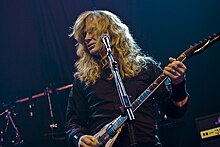
In May 1983, Metallica traveled to Rochester, New York, to record its debut album, Metal Up Your Ass, which was produced by Paul Curcio.[18] The other members decided to eject Mustaine from the band because of his drug and alcohol abuse and violent behavior just before the recording sessions on April 11, 1983.[19] Exodus guitarist Kirk Hammett replaced Mustaine the same afternoon.[17] Metallica's first live performance with Hammett was on April 16, 1983, at a nightclub in Dover, New Jersey, called The Showplace;[16] the support act was Anthrax's original lineup, which included Dan Lilker and Neil Turbin.[20] This was the first time the two bands performed live together.[16]

Mustaine, who went on to form Megadeth, has expressed his dislike for Hammett in interviews, saying Hammett "stole" his job.[21] Mustaine was "pissed off" because he believes Hammett became popular by playing guitar leads that Mustaine had actually written.[22] In a 1985 interview with Metal Forces, Mustaine said, "It's real funny how Kirk Hammett ripped off every lead break I'd played on that No Life 'til Leather tape and got voted No. 1 guitarist in your magazine."[23] On Megadeth's debut album, Killing Is My Business... and Business Is Good! (1985), Mustaine included the song "Mechanix", which Metallica had previously reworked and retitled "The Four Horsemen" on Kill 'Em All. Mustaine said he did this to "straighten Metallica up" because Metallica referred to Mustaine as a drunk and said he could not play guitar.[23]
Because of conflicts with its record label and the distributors' refusal to release an album titled Metal Up Your Ass, the album was renamed Kill 'Em All. It was released on Megaforce Records in the U.S. and on Music for Nations in Europe, and peaked at number 155 on the Billboard 200 in 1986.[24][a] Although the album was not initially a financial success, it earned Metallica a growing fan base in the underground metal scene.[25] To support the release, Metallica embarked on the Kill 'Em All for One tour with Raven.[26] In February 1984, Metallica supported Venom on the Seven Dates of Hell tour, during which the bands performed in front of 7,000 people at the Aardschok Festival in Zwolle, Netherlands.[27]
1984–1986: Ride the Lightning, Master of Puppets, and Burton's death[edit]

Metallica recorded its second studio album, Ride the Lightning, at Sweet Silence Studios in Copenhagen, Denmark, from February to March 1984. It was released in August 1984 and reached number 100 on the Billboard 200.[28] A French printing press mistakenly printed green covers for the album, which are now considered collectors' items. Mustaine received writing credit for "Ride the Lightning" and "The Call of Ktulu".[27]
Elektra Records A&R director Michael Alago and co-founder of Q-Prime Management Cliff Burnstein attended a Metallica concert in September 1984; they were impressed with the performance, signed Metallica to Elektra and made the band a client of Q-Prime Management.[29] Metallica's growing success was such that the band's British label, Music for Nations, released "Creeping Death" as a limited-edition single, which sold 40,000 copies as an import in the U.S. Two of the three songs on the record – cover versions of Diamond Head's "Am I Evil?" and Blitzkrieg's "Blitzkrieg" – appeared on the 1988 Elektra reissue of Kill 'Em All.[30] Metallica embarked on its first major European tour with Tank to an average crowd of 1,300. Returning to the U.S., it embarked on a co-headlining tour with W.A.S.P. and support from Armored Saint. Metallica played its largest show at the Monsters of Rock festival at Donington Park, England, on August 17, 1985, with Bon Jovi and Ratt, playing to 70,000 people. At a show in Oakland, California, at the Day on the Green festival, the band played to a crowd of 60,000.[29]
Metallica's third studio album, Master of Puppets, was recorded at Sweet Silence Studios from September to December 1985 and released in March 1986. The album reached number 29 on the Billboard 200 and spent 72 weeks on the chart.[31] It was the band's first album to be certified Gold on November 4, 1986, and was certified six times Platinum in 2003.[32] Steve Huey of AllMusic considered the album "the band's greatest achievement".[33] Following the release of the album, Metallica supported Ozzy Osbourne on a U.S. tour.[29] Hetfield broke his wrist while skateboarding; he continued with the tour, performing vocals, with guitar technician John Marshall playing rhythm guitar.[34]
On September 27, 1986, during the European leg of Metallica's Damage, Inc. Tour, members drew cards to determine which bunks on the tour bus they would sleep in. Burton won and chose to sleep in Hammett's bunk. At around sunrise near Dörarp, Sweden, the bus driver lost control and skidded, which caused the bus to overturn several times. Ulrich, Hammett and Hetfield sustained no serious injuries; however, Burton was pinned under the bus and died. Hetfield said:
I saw the bus lying right on him. I saw his legs sticking out. I freaked. The bus driver, I recall, was trying to yank the blanket out from under him to use for other people. I just went, "Don't fucking do that!" I already wanted to kill the [bus driver]. I don't know if he was drunk or if he hit some ice. All I knew was, he was driving and Cliff wasn't alive anymore.[34]
1986–1994: Newsted joins, ...And Justice for All and Metallica[edit]
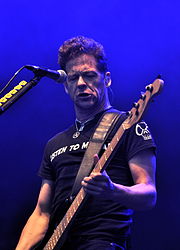
Burton's death left Metallica's future in doubt. The three remaining members decided Burton would want them to carry on, and with the Burton family's blessings, the band sought a replacement.[35] Roughly 40 people – including Hammett's childhood friend, Les Claypool of Primus; Troy Gregory of Prong; and Jason Newsted, formerly of Flotsam and Jetsam – auditioned for the band to fill Burton's spot. Newsted learned Metallica's entire setlist; after the audition, Metallica invited him to Tommy's Joynt in San Francisco. Hetfield, Ulrich and Hammett decided on Newsted as Burton's replacement; his first live performance with Metallica was at the Country Club in Reseda, California. The members initiated Newsted by tricking him into eating a ball of wasabi.[35] The band finished its tour in February 1987.
After Newsted joined Metallica, the band left their El Cerrito practice space – a suburban house formerly rented by sound engineer Mark Whitaker and dubbed "the Metalli-mansion" – and relocated to the adjacent cities of Berkeley and Albany before eventually settling in the Marin County city of San Rafael, north of San Francisco.[36][37] In March 1987, Hetfield again broke his wrist while skateboarding, forcing the band to cancel an appearance on Saturday Night Live. In August 1987, an all-covers extended play (EP), titled The $5.98 E.P. - Garage Days Re-Revisited, was released. The EP was recorded in an effort to use the band's newly constructed recording studio, test Newsted's talents, and to relieve grief and stress following the death of Burton. A video titled Cliff 'Em All commemorating Burton's three years in Metallica was released in 1987; the video included bass solos, home videos and pictures.[38]
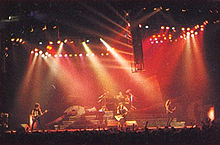
Metallica's first studio album since Burton's death, ...And Justice for All, was recorded from January to May 1988 and released in September. The album was a commercial success, reaching number 6 on the Billboard 200, and was the band's first album to enter the top 10.[28] The album was certified Platinum nine weeks after its release.[39] There were complaints about the production, however; Steve Huey of AllMusic said Ulrich's drums were clicking more than thudding, and the guitars "buzz thinly".[40] To promote the album, Metallica embarked on a tour called Damaged Justice.[41]
In 1989, Metallica received its first Grammy Award nomination for ...And Justice for All in the new Best Hard Rock/Metal Performance Vocal or Instrument category. Metallica was the favorite to win, but the award was given to Jethro Tull for the album Crest of a Knave.[42] The award was controversial with fans and the press; Metallica was standing off-stage waiting to receive the award after performing the song "One". Jethro Tull had been advised by its manager not to attend the ceremony because he was expecting Metallica to win.[42] The award was named in Entertainment Weekly's "Grammy's 10 Biggest Upsets" list.[43]
Following the release of ...And Justice for All, Metallica released its debut music video for the song "One", which the band performed in an abandoned warehouse. The footage was remixed with the film Johnny Got His Gun. Rather than organize an ongoing licensing deal, Metallica purchased the rights to the film. The remixed video was submitted to MTV with an alternative, performance-only version that was held back in case MTV banned the remixed version. MTV accepted the remixed version; the video was viewers' first exposure to Metallica. In 1999, it was voted number 38 in MTV's "Top 100 Videos of All Time" countdown[44] and was featured on the network's 25th-anniversary edition of ADD Video, which showcased the most popular videos on MTV in the last 25 years.[45]
In October 1990, Metallica entered One on One Recording's studio in North Hollywood to record its next album. Bob Rock, who had worked with Aerosmith, The Cult, Bon Jovi and Mötley Crüe, was hired as the producer. Metallica – also known as The Black Album – was remixed three times, cost US$1 million,[46] and ended Hammett and Ulrich's marriages.[47] Although the release was delayed until 1991, Metallica debuted at number one in 10 countries, selling 650,000 units in the U.S. during its first week.[48] The album brought Metallica mainstream attention; it has been certified 16 times Platinum in the U.S., which makes it the 25th-best-selling album in the country.[49] The making of Metallica and the following tour was documented in A Year and a Half in the Life of Metallica. The tour in support of the album, called the Wherever We May Roam Tour, lasted 14 months and included dates in the U.S., Japan and the U.K.[46] In September 1991, 1.6 million rock music fans converged in Moscow to enjoy the first open-air rock concert to be held in the Soviet Union; it was part of the Monsters of Rock series.[50] However, in a June 2020 interview, Lars estimated the attendance at about a half million during their time slot.[51] In April 1992, Metallica appeared at The Freddie Mercury Tribute Concert and performed a three-song set.[52] Hetfield later performed "Stone Cold Crazy" with the remaining members of Queen and Tony Iommi.[52]
On August 8, 1992, during the co-headlining Guns N' Roses/Metallica Stadium Tour at the Olympic Stadium in Montreal, Hetfield suffered second- and third-degree burns to his arms, face, hands and legs. There had been some confusion with the new pyrotechnics setup, which resulted in Hetfield walking into a 12-foot (3.7 m) flame during "Fade to Black".[53] Newsted said Hetfield's skin was "bubbling like on The Toxic Avenger".[54] Metallica returned to the stage 17 days later with guitar technician and Metal Church member John Marshall replacing Hetfield on guitar for the remainder of the tour, although Hetfield was able to sing. Later in 1993, Metallica went on the Nowhere Else to Roam Tour, playing five shows in Mexico City. Live Shit: Binge & Purge, the band's first box set, was released in November 1993. The collection contains three live CDs, three home videos, and a book filled with riders and letters.[54]
1994–2001: Load, Reload, Napster controversy and Newsted's departure[edit]
6 Replies to “Metallica”
Comments are closed.

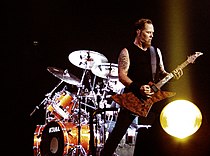
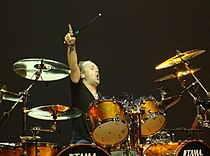
it’s Nice theme.I like it.
yeaaa
gracias
Is not spam, it is only my commercial offer. Sorry if i mistake of topic!
Buy Clomid – Best testimonials. Buy now. Satisfaction is guaranteed.
Best price for brand and generic medications.
From $0.60 per item. Free Airmail shipping for Clomid 100mg 90 tabs and save $135 on order!
fuck off you piece of shit
That Was Great.Thank you My Friend.